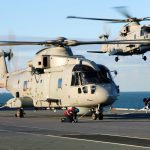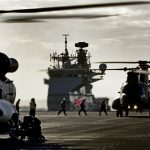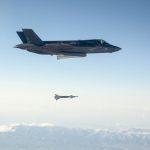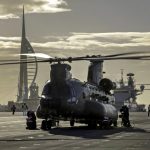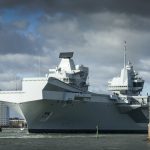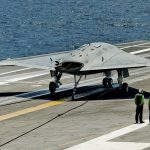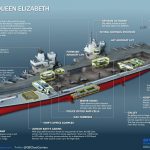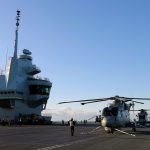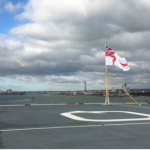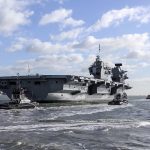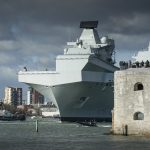HMS Queen Elizabeth
 Britain’s newest aircraft carrier has set sail on its first mission with helicopters — here are all the pictures
Britain’s newest aircraft carrier has set sail on its first mission with helicopters — here are all the pictures
By Kieran Corcoran From Business Insider
The Royal Navy’s largest-ever warship is taking another step towards deploying on operations, and is training at sea with military aircraft for the first time.
HMS Queen Elizabeth, the first in a new class of British military vessels, sailed out of Portsmouth Naval Base on Friday to learn how to work with helicopters on the open waters.
The huge ship, which weighs 65,000 tonnes, is undergoing tests and training in pursuit of its ultimate aim of launching F35-B Lightning jets from its 280-metre flight deck.
Here are the best images of the departure, and its voyage so far:
This is HMS Queen Elizabeth, making its first voyage as an official member of the Royal Navy. Tugboats steered her past the Round Tower which guards the mouth of Portsmouth Harbour. At 56m tall, the carrier dwarfed it.
Crown Copyright
The carrier has sailed before, but only joined the navy for keeps in December, when it was commissioned by Queen Elizabeth II in a grand ceremony.
The highlight was an enormous cake shaped exactly like the ship.
Here’s the carrier heading past Portsmouth’s Spinnaker Tower, with tugboats and a police escort.
Crown Copyright
This is the view of the Queen Elizabeth and the other ships from behind.
Crown Copyright
It’s an impressive piece of hardware — here’s a visual rundown of its stats from the manufacturers.
Aircraft Carrier Alliance
The stern of the ship flew Britain’s Naval Ensign, a flag used by military ships at sea.
The Royal Navy Ensign is flying whilst Portsmouth slowly disappears in to the background.
And the Royal Navy uploaded social media video of the carrier in transit.
Ahead of the departure, two twin-engine Chinook transporter helicopters landed on board, and will take part in the trials.
Crown Copyright
Here’s how the Royal Navy described the purpose of the exercise:
“The aim of the trials is to work out the conditions that the aircraft can operate in while at sea on the carrier.
“They will collect data about the landings, take-offs and manoeuvres in different wind and sea conditions, before processing the information and ultimately declaring that the ship can safely operate the aircraft.”
Here’s another view of the choppers.
Crown Copyright
Chinooks are a mainstay of British air power, and have been in service since 1980.
The 30 metre-long tandem helicopters can carry around 55 people, or 10 tonnes of freight, and fly at around 180mph.
They are not combat craft, but can be equipped with two miniguns and a machine gun.
A few days after, Merlin helicopters flew out to join in, dispatched from Culdrose Royal Naval Air Station in Cornwall.
Crown Copyright
Merlins are a medium-sized transport helicopter. They can carry around 30 troops each and fly at speeds in excess of 190mph.
Crown Copyright
As well as carrying people, they can also carry weapons, such as torpedos and depth charges.
They can also act as scouts, thanks to advanced sensor systems on-board. Each one can scan the seas and send information back to the Queen Elizabeth from hundreds of miles away.
Eventually, 14 Merlins will be stationed on the Queen Elizabeth full-time.
The Queen Elizabeth is the first “twin-island” aircraft carrier in the world. Most carriers have one tower on deck to steer the ship and handle the aircraft, but the Queen Elizabeth split the tasks. They tweeted a view of the assembled helicopters for the read tower, used for flight.
Looking out of the forward windows in flyco. On the flightdeck is 3 Merlin and 1 chinook.Looking out of the aft windows in flyco a Merlin and a chinook
Eventually HMS Queen Elizabeth ship will carry F-35B Lightning fighter jets, which will launch from its ski jump-style ramp. Here are the planes practising in at an air base in the US.
Here’s an F-35B in action — this one belongs to the US Marine Corps and was testing munitions over the California desert.
Reuters
In the future, the Queen Elizabeth could also be a platform for drones. Here’s a Northrop Grumman X-47B combat drone on the flight deck of American carrier USS George Bush.
Reuters
Captain Jerry Kyd, the commanding officer of HMS Queen Elizabeth, told Business Insider in an interview last year that “it’s an absolute inevitability that [drones are] going to be embarked on this ship in the near future.”
You can read our full interview at web link below.
The carrier was last seen off the coast of Cornwall, the southwestern tip of the UK. This photo was taken by a local newspaper photographer, showing the ship near the St Michael’s Mount landmark.
It’s not clear where the training exercise will take it next.

